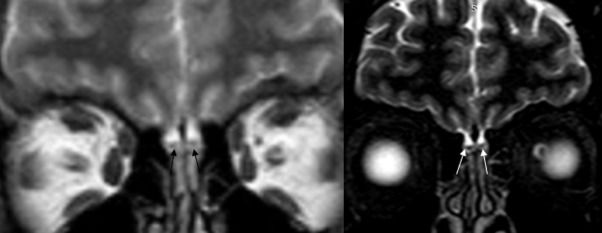Brain Images Show Olfactory Impact in Patient with Early-Stage COVID-19 Infection
Images similar to those found in patients with anosmia associated with other types of coronavirus infections.

As details have continued to emerge about the presentation of COVID-19 infection in patients, an increasing number of cases with a loss of the sense of smell have been reported. New MRI images reveal some characteristics of how the virus impacts the olfactory bulb (OB).
Published in Academic Radiology, the study, submitted by the Chronic Respiratory Diseases Research Center, National Research Institute of Tuberculosis and Lung Diseases at Shahid Beheshti University of Medical Sciences in Iran, shows an OB MRI of a 27-year-old man who tested positive for COVID-19 infection who was both in the early disease phase and presented with secondary isolated loss of smell.
According to the investigators, it is the first report of this type of finding. The results, they indicated were reminiscent of previous anosmia cases associated with other viral infections.
“Despite the sudden onset of a complete loss of olfactory function, we found normal OB volume without abnormal signal intensity in the OB and tract and no sign of nasal congestion,” they said. “This finding is consistent with prior reports in 2002-2003 of SARS-CoV-induced anosmia, where OB MRI similarly did not demonstrate abnormal findings.”
Even though the OB MRI findings were normal, the investigators said using hybrid imaging could provide more information. For example, they suggested single-photon emission computed tomography-MRI with nasal thalium-21 that facilitates the analysis of the olfactory nerve connectivity in patients who have a reduced sense of smell. Additionally, other MRI protocol sequences, such as magnetization-prepared rapid gradient echo sequence – one that captures high tissue contrast and provides high spatial resolution with a short whole-brain scan time – can help pinpoint olfactory system abnormalities caused by the SARS-CoV-2 virus.
More imaging is needed, though, to unearth the details of COVID-19 impacts the olfactory system, they said.
“We suggest future studies in patients with isolated anosmia secondary to COVID-19 to perform OB MRI longitudinally both in the acute phase and in follow-up to assess for possible temporal evolution of the imaging findings,” the investigators said.
New MRI Research Explores Links Between Waist-to-Hip Ratio and Memory in Aging
March 13th 2025Researchers found that a higher waist-to-hip ratio in midlife was associated with higher mean diffusivity in 26 percent of total white matter tracts in the cingulum as well as the superior and inferior longitudinal fasciculus.
Is MRI Contrast Enhancement Necessary for Long-Term Monitoring of Diffuse Glioma?
March 4th 2025In a comparison of contrast-enhanced T1-weighted (CET1w) MRI (and T2-weighted MRI/FLAIR imaging, researchers found that only three out of 82 cases of glioma progression were solely detected with CET1w MRI.